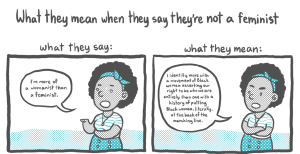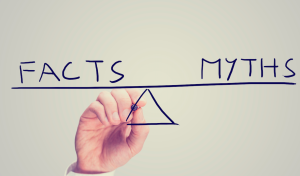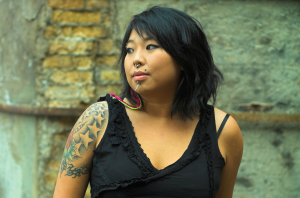I remember when an acquaintance naively asked me, “If you’re non-binary, you don’t experience body dysphoria, right?”
Ouch.
As a trans person who experiences dysphoria, which is the distress or discomfort that occurs when the gender someone is assigned does not align with their actual gender, nearly every day, the myths surrounding it – like that one – hit me right in the feels.
It’s a very difficult part of my reality as trans – and the assumptions made about my experience can make it all the more painful.
And while it’s true that trans issues are more visible than before, some of the very basic myths around our experience (or lack thereof) of body dysphoria still prevail.
Visibility is not always, by default, a good thing – especially if that visibility is so limited that it creates a very narrow idea of what the experience of being transgender is really like. A lack of real, authentic narratives only feeds into the myths that surround our experiences.
Those myths ultimately create two major issues: 1) Cisgender folks can’t understand our experiences, and 2) transgender folks begin to doubt their experiences because they aren’t considered “the norm.”
So it’s about time that we unpack some of those myths.
Let’s start with these five.
Myth #1: Body Dysphoria Happens Because You’re in the ‘Wrong Body’
The short answer? Not necessarily.
Some trans folks with dysphoria do sincerely believe that they were born into the wrong body and were meant to have an entirely different one. However, not every trans person with dysphoria believes that to be true.
Saying that our bodies are “wrong” can sometimes suggest that we’re inherently flawed – or that our being trans is a “mistake,” rather than a part of our identity.
Sometimes it’s not about the wrong body – it’s about needing modifications to feel more at home. And many people, cis and trans, opt for dressing or modifying their bodies in a different way to make it more their own.
If you mostly liked your house, but wanted a different wall color, you probably wouldn’t tear down the entire house and move somewhere else just to have green walls, right?
Everyone’s experience of dysphoria is different, so imposing the “wrong body” narrative onto everyone’s experience is far too large of a generalization to be accurate for every single transgender person.
Often times the “wrong body” narrative is really just a shortcut so that cisgender folks don’t have to actually engage with or learn about the experiences of trans folks.
It dismisses the complexity of our experiences in favor of a quick explanation of our existence so that real, nuanced conversations don’t have to take place.
But instead of oversimplifying, what we really should be doing is taking the time to learn about trans folks, and opening up real conversations – not shutting down conversation by explaining us away with a problematic stereotype.
That is: It’s best to let each trans person define their experiences with their bodies in their own words.
Myth #2: Body Dysphoria Is Necessary to Being Trans
Nope!
Some trans folks don’t experience body dysphoria at all. Some experience social dysphoria, which is a discomfort with how they’re perceived and misgendered within society. And some trans folks experience neither body nor social dysphoria at all.
This gets confusing for some folks, who strongly associate gender identity with biological sex. But the reality is that sex and gender are different. There’s not necessarily a correlation.
Because sex and gender are different, and everyone’s experience of sex and gender is different, you’ll find trans folks with a wide variety of understandingsaround their bodies.
For example, although I was assigned female at birth, I don’t consider my genitalia to be female. Consequently, I’m not uncomfortable with that part of my body – because I don’t consider it to be a contradiction to my gender identity.
It’s just a body part, like an elbow, or a nose. There is nothing gendered about elbows or noses – they simply are. I still experience body dysphoria, primarily around my chest; sometimes our mental maps just work out that way.
There are plenty of trans folks who experience dysphoria around sexed parts of the body, and plenty who won’t. And it’s not right or wrong – it’s just the way that they relate to their body.
Trans folks may have a lot of dysphoria or none at all – but most will have gender euphoria. That is, euphoria or happiness upon being correctly gendered, upon naming their identity, and being validated and recognized as their authentic self.
I like to think that it’s the euphoria – not the dysphoria – that makes a person trans.
Ultimately, being transgender is not about our bodies, as much as it’s about how strongly we identify with societally created gender categories.
That, on its own, will not predict the kind of relationship we have with our bodies. Thus, not every trans person will experience body dysphoria, and that’s totally okay.
Myth #3: Body Dysphoria Is Essentially Experienced the Same for Every Trans Person
If it isn’t obvious by now, trans folks do not experience body (or social) dysphoria in the same way.
Some of us don’t experience it at all, some of us feel it every day, and some of us fall somewhere in-between.
Sometimes the severity is quite intense; for others, their dysphoria is mild. Sometimes the severity varies day-to-day.
Some of us feel dysphoric about our hips. Some about our faces. Some about our hands! Some about our chests. Sometimes I feel dysphoric about my uterus, even though I can’t see it.
Sometimes it’s just a lingering anxiety that isn’t centered around a specific body part, but rather a tension that we can’t let go of.
No two trans people experience dysphoria in an identical way, so it’s best to leave your assumptions at the door.
Myth #4: With a Little Self-Love and a Better Attitude, Body Dysphoria Can Be Fixed
I’ve been told that I wouldn’t be dysphoric if I had higher self-esteem.
“All you need is self-love,” I was told. “Be a little more body positive!”
For some reason, there are a lot of people who believe that body dysphoria is an issue of self-esteem. But I can tell you that, as someone who is pretty into themselves, self-love is not something I’m lacking – and yet I still have an abundance of dysphoria.
So what gives?
Well, being transgender isn’t about hating yourself. For me, it’s about aligning who you are on the inside with what’s visible on the outside. Transitioning was my greatest act of self-love.
Instead of existing in a body that distorted my truth, I decided to embrace who I was and make that self visible to myself and to others.
Similarly, I’m not looking to get top surgery because I hate myself. It’s because my chest interferes with making my true self and my gender visible. What I see on the outside doesn’t align with what I feel on the inside, and it creates a lot of chaos and discomfort.
Discomfort about my body doesn’t mean I hate myself, and that applies whether you’re transgender or cisgender.
My dysphoria is caused by a body that erases who I know myself to be – and who I love being.
Body dysphoria is not a “mind over matter” situation. Body dysphoria is not something that just takes a little willpower to “get over.”
And it’s invalidating (and presumptuous!) to say that it’s somehow my fault that I’m experiencing it.
Myth #5: Non-Binary and Genderqueer People Don’t Experience Body Dysphoria
Right. So about that acquaintance…
Um, hi there! Genderqueer person with body dysphoria, right here.
There are plenty of folks who are non-binary or genderqueer that also experience body dysphoria.
I’ve written about my really scary experiences with dysphoria before, and what folks can do to support someone who’s living through it. And far and away, the most common response was that people simply had no idea that a genderqueer person could experience this kind of body dysphoria!
It’s true, though. There are plenty of folks who are non-binary or genderqueer that have experiences with body dysphoria. And those experiences are just as legitimate, overwhelming, and at times debilitating as any other binary trans person.
Sometimes there’s this misconception that non-binary people aren’t completely trans, or that their experiences of being trans are somehow less serious, less valid, or less sincere. This myth extends over to our experiences with dysphoria, too, which are often assumed to not exist or not be as serious.
You can nip that right in the bud, though: Non-binary people’s experiences of their gender and of dysphoria are just as important, serious, and valid as any binary person. Period.
***
I could write a whole book full of myths about body dysphoria.
There’s a lot of confusion and mystery surrounding it: Many people want to know what it’s like, but are afraid to ask because it can be such a painful experience.
But the truth of the matter is that body dysphoria (and gender dysphoria more generally) is different for each and every trans person.
It’s difficult to impose a single narrative on such a unique experience, and consequently, even transgender people themselves often wonder if what they’re experiencing is dysphoria!
It’s okay to be curious and to want to know more about our experiences.
However, it can be harmful to perpetuate stereotypes – which is why it’s better to keep an open mind and to allow trans folks to define their own experiences.
Because really, there could be as many experiences of dysphoria as there are trans folks in this world.
So before you assume, take a step back and remember: Every one of us is the expert on our own body and (a)gender, no matter how we identify!
[do_widget id=”text-101″]
Sam Dylan Finch a Contributing Writer for Everyday Feminism. He is queer writer, activist, and educator based in the San Francisco Bay Area. In addition to his work at Everyday Feminism, he is also the founder of Let’s Queer Things Up!, his hella queer and very awesome blog. You can learn more about him here and read his articles here. Follow him on Twitter @samdylanfinch.
Search our 3000+ articles!
Read our articles about:
Our online racial justice training
Used by hundreds of universities, non-profits, and businesses.
Click to learn more





















